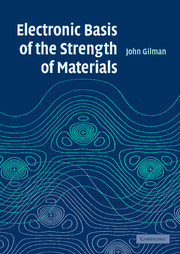Book contents
- Frontmatter
- Contents
- Preface
- Section I Introduction
- Section II Elements of solid mechanics
- Section III Elements of electron mechanics
- Section IV Elastic stiffness
- 9 Cohesion of atoms
- 10 Intramolecular cohesion
- 11 Intermolecular cohesion
- 12 Bulk modulus
- 13 Shear modulus
- 14 Entropic elasticity (polymers)
- 15 Universality and unification
- Section V Plastic strength
- Section VI Fracture resistance
- Index
- References
9 - Cohesion of atoms
Published online by Cambridge University Press: 14 August 2009
- Frontmatter
- Contents
- Preface
- Section I Introduction
- Section II Elements of solid mechanics
- Section III Elements of electron mechanics
- Section IV Elastic stiffness
- 9 Cohesion of atoms
- 10 Intramolecular cohesion
- 11 Intermolecular cohesion
- 12 Bulk modulus
- 13 Shear modulus
- 14 Entropic elasticity (polymers)
- 15 Universality and unification
- Section V Plastic strength
- Section VI Fracture resistance
- Index
- References
Summary
The ideas involved in the theory of cohesion which underlies the theory of strength are relatively simple, although the details may be intricate. The most important forces that give high cohesion, and therefore high strength, are electrostatic so the theory might be said to have begun with Benjamin Franklin (1752). He speculated, based on his studies of electrostatics, that charges were somehow involved in cohesion. Later, Berzelius (1819) proposed that atomic particles with net positive and negative charges attract one another thereby forming chemical bonds. However, this did not account for the binding between atomic particles of the same electrostatic sign.
Verification of these speculations came only after a century of advances in technology. Methods for conveniently generating, storing, and handling electricity had to be developed as well as improved methods for evacuating containers. During his search for effective incandescent filaments, the improved vacua that he developed led Thomas Edison (1884) to the discovery that hot conductive filaments emit electricity that can flow to positive collectors through vacua. One of the consequences of this discovery, occurring about ten years later, was that Wilhelm Roentgen (1895) discovered X-rays.
Although atomic theories of matter had been postulated for millennia, and estimates of atomic spacings and structures in crystals could be made on the basis of the work of Boyle, Dalton, and Faraday, definitive measurements did not exist. Then, 17 years after Roentgen's discovery, Max von Laue (1912) showed that X-rays can be diffracted by crystals.
- Type
- Chapter
- Information
- Electronic Basis of the Strength of Materials , pp. 63 - 76Publisher: Cambridge University PressPrint publication year: 2003



